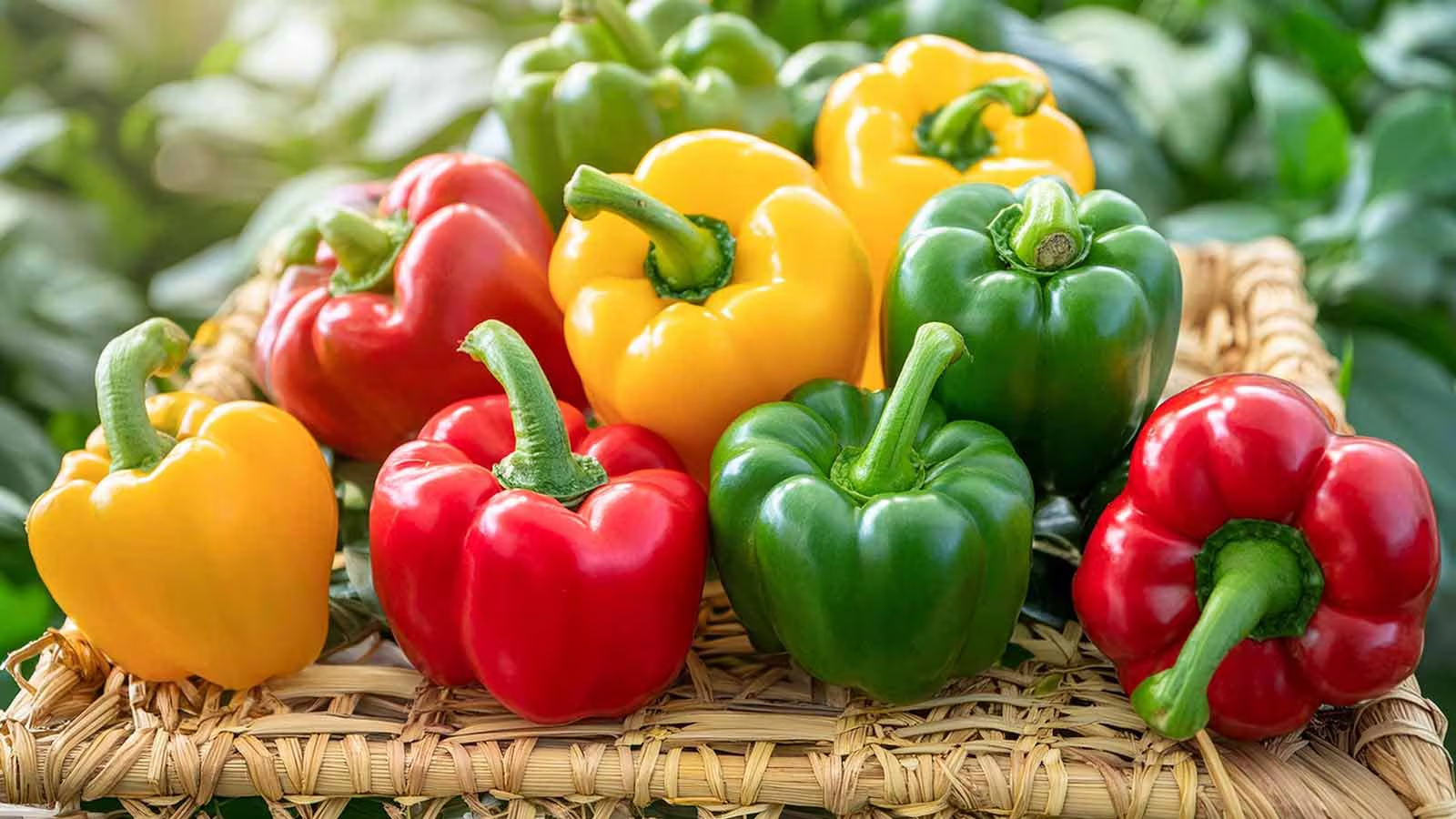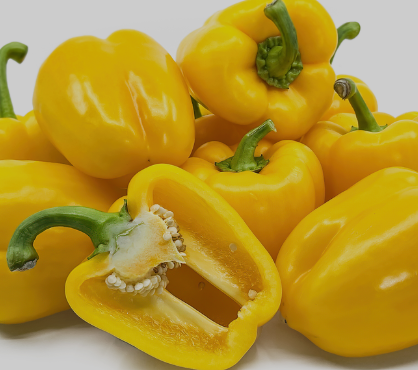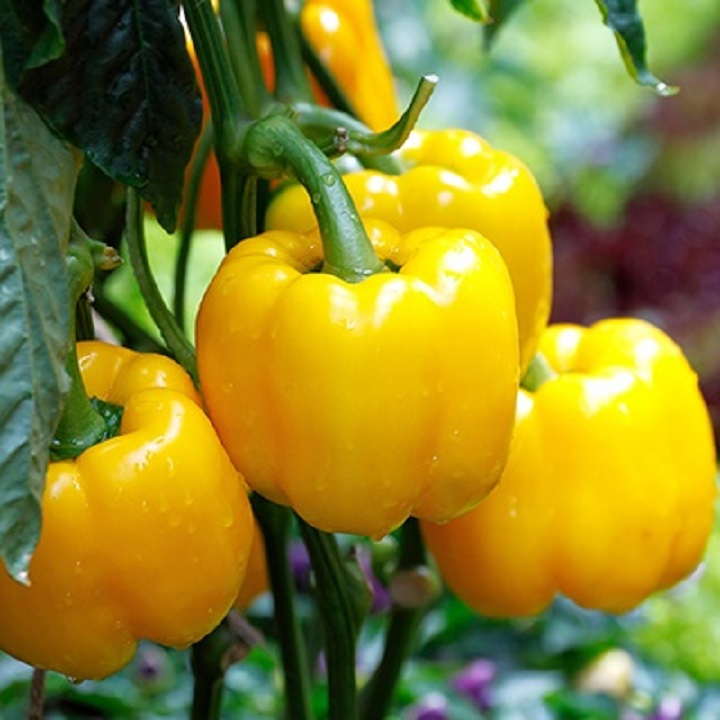
Yellow Peppers
Table of Contents
Elevate Your Dishes with Yellow Peppers
Introduction:
Yellow peppers, with their bright, sunny hue and sweet, mild flavor, are a versatile ingredient that can transform ordinary dishes into extraordinary culinary delights. Whether you’re grilling, roasting, sautéing, or eating them raw, yellow peppers add a burst of color, nutrition, and taste to any meal. In this article, we’ll explore the benefits of yellow peppers, their culinary uses, and some delicious recipes to help you incorporate them into your cooking.
Why Choose Yellow Peppers?
Yellow peppers, also known as yellow bell peppers, are part of the Capsicum annuum family, which includes red, orange, and green varieties. They are prized for their:
1. Sweet and Mild Flavor
Unlike green peppers, which can be slightly bitter, peppers have a naturally sweet and fruity taste. This makes them perfect for salads, stir-fries, and even desserts.
- Proteins – Chicken, fish, shrimp, and tofu
- Grains – Quinoa, rice, couscous, and pasta
- Dairy – Feta, goat cheese, halloumi, and cream-based sauces
- Herbs & Spices – Basil, thyme, paprika, cumin, and garlic
2. Vibrant Color and Presentation
The bright yellow hue adds visual appeal to any dish, making it more appetizing. Chefs often use them to enhance the presentation of gourmet meals.
3. Nutritional Benefits
Peppers are packed with essential nutrients, including:
- Vitamin C (Higher than oranges!) – Boosts immunity and skin health.
- Vitamin A – Supports vision and immune function.
- Fiber – Aids digestion and promotes gut health.
- Antioxidants – Helps fight inflammation and oxidative stress.
4. Low in Calories
With only about 50 calories per medium-sized pepper, they are a great addition to weight-conscious diets.
Culinary Uses of Yellow Peppers
Peppers can be used in countless ways in the kitchen. Here are some of the best methods to incorporate them into your meals:
1. Raw in Salads and Snacks
Their crisp texture and sweetness make them perfect for:
- Fresh salads (Greek salad, coleslaw, or a simple pepper and cucumber mix).
- Crudité platters – Pair with hummus or guacamole.
- Sandwiches and wraps – Adds crunch and sweetness.
2. Roasted or Grilled
Roasting or grilling enhances their natural sweetness and adds a smoky depth. Try them in:
- Stuffed peppers – Fill with quinoa, cheese, or ground meat.
- Grilled vegetable skewers – Combine with zucchini, mushrooms, and onions.
- Roasted pepper soup – Blend with garlic and cream for a velvety texture.
3. Sautéed or Stir-Fried
Peppers retain their crunch when lightly cooked, making them ideal for:
- Stir-fries – Pair with chicken, beef, or tofu.
- Fajitas – Sauté with onions and spices.
- Pasta dishes – Toss with olive oil, garlic, and shrimp.
4. Blended into Sauces and Dips
Their natural sweetness works well in:
- Yellow pepper coulis – Drizzle over fish or grilled meats.
- Hummus or spreads – Blend with chickpeas and tahini.
- Salsas – Mix with mango or pineapple for a tropical twist.
Delicious Yellow Pepper Recipes to Try
Now that you know how versatile yellow peppers can be, here are three mouthwatering recipes to inspire you:
1. Stuffed Yellow Peppers with Quinoa and Feta
Ingredients:
- 4 large yellow peppers, halved and deseeded
- 1 cup cooked quinoa
- ½ cup crumbled feta cheese
- ¼ cup chopped parsley
- 1 small red onion, diced
- 2 cloves garlic, minced
- 1 tsp olive oil
- Salt and pepper to taste
Instructions:
- Preheat oven to 375°F (190°C).
- In a pan, sauté onion and garlic in olive oil until soft.
- Mix quinoa, feta, parsley, and sautéed onions in a bowl.
- Stuff the pepper halves with the mixture.
- Bake for 25-30 minutes until peppers are tender.
- Serve warm with a sprinkle of fresh herbs.
2. Yellow Pepper and Corn Chowder
Ingredients:
- 2 yellow peppers, diced
- 1 cup corn kernels (fresh or frozen)
- 1 potato, diced
- 1 onion, chopped
- 2 cups vegetable broth
- 1 cup coconut milk
- 1 tbsp butter
- Salt, pepper, and paprika to taste
Instructions:
- In a pot, melt butter and sauté onions until translucent.
- Add peppers, corn, and potatoes, cooking for 5 minutes.
- Pour in broth and simmer until potatoes are soft.
- Blend half the soup for creaminess, then stir in coconut milk.
- Season and serve with crusty bread.
3. Grilled Yellow Pepper and Halloumi Skewers
Ingredients:
- 2 yellow peppers, cut into chunks
- 1 block halloumi cheese, cubed
- 1 zucchini, sliced
- 2 tbsp olive oil
- 1 tsp dried oregano
- Lemon wedges for serving
Instructions:
- Thread peppers, halloumi, and zucchini onto skewers.
- Brush with olive oil and sprinkle with oregano.
- Grill on medium heat for 3-4 minutes per side.
- Serve with lemon wedges and a fresh salad.
Tips for Selecting and Storing Yellow Peppers
- Choosing the best peppers: Look for firm, glossy skin with no wrinkles or soft spots.
- Storage: Keep them in the fridge for up to a week. For longer storage, chop and freeze.
- Prepping: Remove seeds and white membranes for a smoother texture.
Creative Ways to Use Yellow Peppers in Your Cooking
1.Pepper Puree for Gourmet Plating
A silky yellow pepper puree can elevate a simple dish into a restaurant-worthy masterpiece. Here’s how to make it:
- Roast 2-3 yellow peppers until charred, then peel off the skin.
- Blend with a splash of olive oil, salt, and a touch of honey for extra sweetness.
- Use as a base for grilled meats, fish, or roasted vegetables.
2. Pickled Yellow Peppers for a Tangy Twist
Pickling peppers preserves their crunch while adding a zesty kick. Try this quick recipe:
- Slice peppers thinly and pack into a jar.
- Heat equal parts vinegar and water with sugar, salt, and spices (like mustard seeds or peppercorns).
- Pour the hot liquid over the peppers and refrigerate for at least 24 hours.
- Use in sandwiches, tacos, or as a garnish for cheese boards.
3. Yellow Pepper Jam for Sweet & Savory Pairings
Turn peppers into a unique jam that pairs well with cheeses, grilled meats, or even toast:
- Cook diced peppers with sugar, lemon juice, and a pinch of chili flakes.
- Simmer until thick, then blend for a smooth consistency.
- Serve alongside brie, roasted pork, or crusty bread.
Health Benefits: Why Yellow Peppers Deserve a Spot in Your Diet

Beyond their delicious taste, peppers offer impressive health perks:
- Rich in Antioxidants – Helps combat free radicals and supports skin health.
- Boosts Immunity – High vitamin C content strengthens the immune system.
- Promotes Eye Health – Contains lutein and zeaxanthin, which protect vision.
- Aids Digestion – The fiber content supports a healthy gut.
Expert Tips for Cooking with Yellow Peppers
- Char Them for Smoky Depth – Roasting over an open flame or under a broiler enhances their natural sugars.
- Keep Some Crunch – If using in stir-fries or salads, avoid overcooking to maintain texture.
- Pair with Acid – A squeeze of lemon or balsamic vinegar balances their sweetness.
- Use in Place of Tomatoes – In sauces or soups, yellow peppers add a milder, sweeter alternative.
Final Thoughts:
Peppers are a simple yet transformative ingredient that can brighten flavors, add nutrition, and make every meal more visually appealing. Whether you’re blending them into sauces, grilling them for smoky sweetness, or pickling them for a tangy bite, there’s no limit to how you can use them.
Ready to experiment? Pick up some fresh peppers on your next grocery run and start incorporating them into your favorite dishes. Your taste buds—and your Instagram feed—will thank you!
FAQs:
How Can Peppers Transform Your Cooking?
How Can Yellow Peppers Transform Your Cooking?
Yellow peppers add vibrant color, sweet flavor, and crisp texture to dishes. Their versatility shines in salads, stir-fries, roasted meals, and sauces. Packed with vitamin C and antioxidants, they boost both nutrition and presentation. From stuffed peppers to gourmet purees, they elevate everyday cooking into something extraordinary. A kitchen essential!
What Are the Best Recipes for Yellow Peppers?
Best Yellow Pepper Recipes to Try:
Stuffed Peppers – Fill with quinoa, ground meat, or cheese for a hearty meal.
Roasted Pepper Soup – Blended with garlic and cream for velvety richness.
Grilled Pepper Skewers – Pair with halloumi and zucchini for smoky sweetness.
Yellow Pepper Hummus – A vibrant twist on classic dip.
Stir-Fries – Adds crunch and color to Asian-inspired dishes.
Why Should You Add Yellow Peppers to Your Meals?
Why Add Yellow Peppers to Your Meals?
Yellow peppers boost flavor, nutrition, and visual appeal. Their sweet, mild taste enhances salads, stir-fries, and roasted dishes. Packed with vitamin C (more than oranges!), antioxidants, and fiber, they support immunity and digestion. Low in calories yet high in crunch, they’re perfect for weight-conscious meals. A simple way to make everyday cooking brighter and healthier.
How Do Yellow Peppers Enhance Flavor in Dishes?
How Peppers Elevate Your Dishes’ Flavor
Yellow peppers bring a unique sweet-crisp dimension that transforms ordinary meals. Their natural sugars caramelize beautifully when roasted, adding depth to sauces and soups. Unlike green peppers’ bitterness, their mild fruitiness balances spicy, savory, and tangy flavors perfectly. They absorb seasonings well while maintaining their distinct character, making them ideal for stir-fries, stuffed dishes, and fresh salads. A versatile flavor booster,
How Do Yellow Peppers Enhance Flavor in Dishes?
The Flavor Magic of Yellow Peppers
Yellow peppers bring natural sweetness and subtle fruitiness that brightens any dish. Their mild flavor balances spices while adding refreshing crunch. When cooked, they caramelize beautifully, deepening sauces and stir-fries. Unlike green peppers’ bitterness, they complement rather than overpower other ingredients. Perfect raw in salads or roasted in Mediterranean dishes, they’re versatile flavor enhancers that elevate both taste and presentation.











